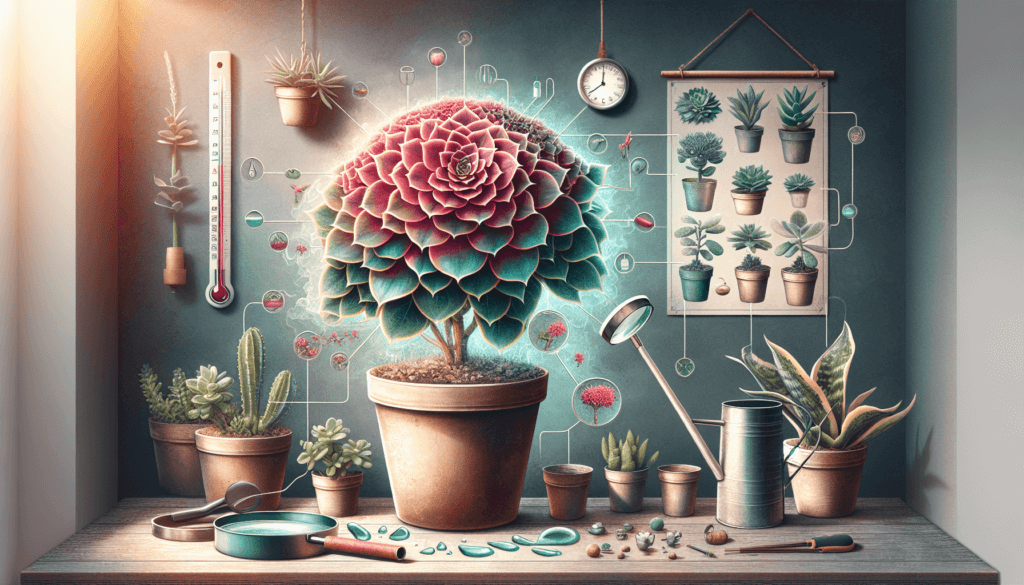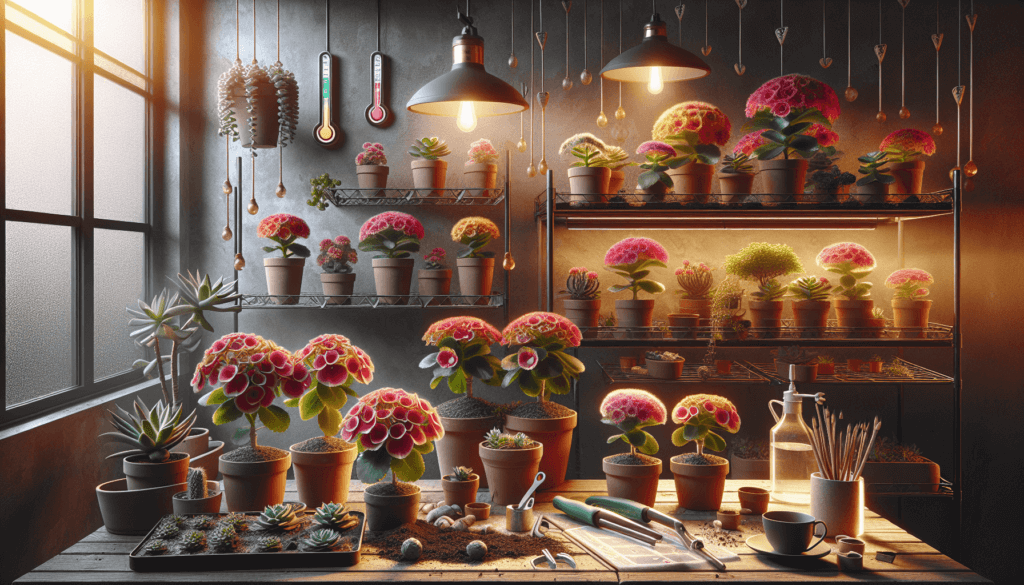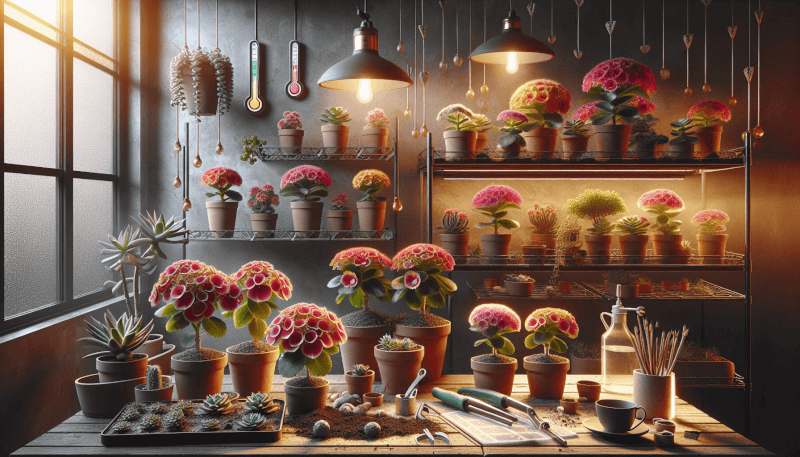Are you a plant lover looking to add a touch of beauty to your indoor space? Look no further than the Kalanchoe plant. Known for its vibrant flowers and resilience, the Kalanchoe is a popular choice for indoor gardens. In this article, we will explore the essentials of Kalanchoe plant care indoors, including watering, lighting, and pruning techniques. Whether you’re a seasoned plant parent or just starting your green journey, we’ve got you covered with all the tips and tricks to help your Kalanchoe thrive in your home.
Choosing the Right Kalanchoe Plant
Consider the Different Varieties
When choosing a Kalanchoe plant for your indoor space, it’s important to consider the different varieties available. Kalanchoe plants come in a range of beautiful colors and sizes, so you have plenty of options to choose from. Some popular varieties include the Kalanchoe blossfeldiana, which features vibrant blooms in shades of red, pink, orange, and yellow, and the Kalanchoe tomentosa, also known as the panda plant, with its fuzzy leaves. Take the time to research the different varieties and choose one that suits your personal preferences and the aesthetic of your space.
Look for Healthy Plants
Once you have decided on the variety of Kalanchoe plant you want, it’s essential to look for healthy plants when making your purchase. Healthy plants will have vibrant, glossy leaves and sturdy stems. Avoid plants with yellowing leaves, spots, or signs of wilting, as these can indicate poor health. It’s also wise to inspect the soil for any signs of pests or disease. By selecting a healthy plant from the start, you are setting yourself up for success in caring for your Kalanchoe plant.
Check the Lighting Requirements
Another crucial factor to consider when choosing a Kalanchoe plant is its lighting requirements. Different varieties of Kalanchoe have different preferences when it comes to light. While some varieties thrive in bright, indirect light, others prefer more shade. Be sure to read the care instructions or consult with a plant expert to determine the lighting needs of your chosen Kalanchoe plant. By providing the right lighting conditions, you can ensure the health and vitality of your plant for years to come.
Providing Proper Lighting
Know the Lighting Preferences
To provide proper lighting for your Kalanchoe plant, it’s essential to understand its lighting preferences. Most Kalanchoe varieties prefer bright, indirect light. This means placing the plant near a window that receives plenty of natural light but ensuring that the sunlight doesn’t directly hit the leaves. Fluorescent lighting can also be a suitable alternative for Kalanchoe plants that require less natural light. Make sure to research the lighting requirements of your specific Kalanchoe plant to ensure it thrives in its new environment.
Place the Plant Near a Window
One of the easiest ways to provide your Kalanchoe plant with proper lighting is by placing it near a window. As mentioned earlier, bright, indirect light is the ideal condition for most Kalanchoe varieties. By positioning your plant near a window, you can take advantage of the natural light that filters through. However, be cautious of direct sunlight, as it can scorch the leaves and cause damage. If you notice your Kalanchoe plant leaning towards the window, rotate it regularly to promote even growth.
Consider Using Artificial Lighting
If you don’t have access to ample natural light or your Kalanchoe plant requires less light, consider using artificial lighting to supplement its needs. Grow lights or fluorescent bulbs are excellent options for providing the necessary light intensity and spectrum for your plant’s growth. Position the lights at the appropriate distance from the plant, following the manufacturer’s guidelines. Remember to consider the duration of light exposure as well, as Kalanchoe plants still require periods of darkness to thrive.

Maintaining the Ideal Temperature
Understand Temperature Preferences
Just like any other plant, Kalanchoe plants have specific temperature preferences that must be met to ensure their well-being. Most varieties prefer temperatures between 60 and 75 degrees Fahrenheit (15 to 24 degrees Celsius). They can tolerate slightly cooler temperatures but are sensitive to freezing temperatures. It’s crucial to familiarize yourself with the temperature requirements of your Kalanchoe plant to create a suitable environment for its growth.
Avoid Extreme Temperature Variations
While Kalanchoe plants can withstand varying temperatures to some extent, it’s best to avoid extreme temperature variations to prevent stress and damage. Rapid fluctuations in temperature can cause wilting, leaf discoloration, and even death in severe cases. Keep your Kalanchoe plant away from drafty areas, such as windows and doors, as these can expose the plant to significant temperature changes. Maintaining a stable and consistent temperature is key to ensuring the health of your Kalanchoe plant.
Monitor the Temperature Indoors
To maintain the ideal temperature for your Kalanchoe plant, it’s essential to monitor the temperature indoors regularly. Use a thermometer to track the temperature in the area where your plant is located. Consider using a space heater or air conditioner to help regulate the temperature if necessary. If the temperature drops below the desired range, you can use a plant heating mat or move the plant to a warmer area temporarily. By paying attention to the temperature, you can create a comfortable and conducive environment for your Kalanchoe plant to thrive.
Watering Correctly
Learn the Watering Needs
Proper watering is crucial for the health of your Kalanchoe plant. However, it’s important to note that different Kalanchoe varieties have varying watering needs. In general, Kalanchoe plants prefer well-draining soil and should be watered thoroughly but infrequently. Take the time to research the specific watering requirements of your chosen variety to avoid over- or under-watering.
Allow the Soil to Dry Between Waterings
To prevent over-watering, it’s important to allow the soil to dry between waterings. Kalanchoe plants are susceptible to root rot if they sit in soggy soil for extended periods. Stick your finger about an inch into the soil, and if it feels dry, it’s time to water your Kalanchoe plant. Ensure that water drains freely from the pot, and remove any excess water that collects in the saucer. Remember, it’s better to underwater than overwater your Kalanchoe plant, as it can tolerate short periods of drought.
Avoid Overwatering
Overwatering is one of the most common mistakes when caring for Kalanchoe plants. Excessive moisture can lead to root rot, which can be fatal for your plant. It’s important to avoid overwatering by following the “soak and dry” method. This means thoroughly watering the plant until water drains out of the pot, then allowing the soil to dry out before watering again. Be mindful of the pot’s drainage capabilities and adjust your watering frequency accordingly. By adopting a cautious approach to watering, you can keep your Kalanchoe plant healthy and happy.

Fertilizing the Kalanchoe Plant
Know the Fertilizer Requirements
Fertilizing your Kalanchoe plant is essential in providing it with the necessary nutrients for growth and blooming. However, it’s important to know the specific fertilizer requirements of your plant. Most Kalanchoe varieties benefit from a balanced fertilizer with equal ratios of nitrogen, phosphorus, and potassium (N-P-K). Before fertilizing, research the type and concentration of fertilizer suitable for your Kalanchoe plant.
Use a Balanced Fertilizer
When selecting a fertilizer for your Kalanchoe plant, opt for a balanced formula. A balanced fertilizer, such as a 10-10-10 or 14-14-14, provides equal amounts of nitrogen, phosphorus, and potassium. This ensures that your plant receives all the essential nutrients it needs for healthy growth and vibrant blooms. Follow the instructions on the fertilizer package regarding dosage and frequency of application. It’s best to fertilize your Kalanchoe plant during the active growing season for optimal results.
Fertilize During the Growing Season
To promote healthy growth and encourage blooming, it’s important to fertilize your Kalanchoe plant during the active growing season. Typically, this is during spring and summer when the plant is actively producing new leaves and flowers. However, it’s important to note that not all Kalanchoe varieties have the same growing seasons. Before fertilizing, research the specific growth patterns and seasons of your chosen Kalanchoe plant. By providing the right nutrients at the right time, you can help your plant thrive and achieve its full potential.
Pruning and Deadheading
Remove Dead or Dying Leaves
Regular pruning and deadheading are important for maintaining the appearance and health of your Kalanchoe plant. Start by removing any dead or dying leaves. These can be easily identified as they will have turned yellow or brown and have lost their turgidity. Use a clean pair of pruning shears or scissors to remove these leaves at their base. Pruning helps prevent the spread of disease and allows the plant to focus its energy on healthy growth.
Pinch Back to Promote Bushier Growth
If you want your Kalanchoe plant to have a more compact and bushy appearance, consider pinching back the stems. Pinch off the tips of the stems using your fingers or pruning shears. This encourages the plant to produce new side shoots, resulting in a fuller and more aesthetically pleasing plant. Regular pinching can also help prevent the plant from becoming leggy and sparse over time.
Remove Spent Flowers
To keep your Kalanchoe plant looking its best, it’s important to remove spent flowers. As the flowers fade and start to wilt, trim them off using pruning shears or scissors. This process, known as deadheading, prevents the plant from wasting energy on seed production and encourages it to produce more blooms. Regular deadheading also promotes a tidy and attractive appearance. Be sure to dispose of the removed flowers properly to avoid any potential pests or diseases.
Dealing with Common Pest and Disease Problems
Identify Common Pests
While Kalanchoe plants are generally resilient, they can still be susceptible to pests. Some common pests that can affect Kalanchoe plants include aphids, mealybugs, spider mites, and scale insects. Monitor your plant regularly for any signs of infestation, such as webbing, sticky residue, or distorted leaves. Identifying the pest early on is crucial for effective treatment and prevention.
Use Natural Remedies or Insecticidal Soap
If you notice pests on your Kalanchoe plant, there are several options for controlling them. For minor infestations, you can try using natural remedies such as neem oil, insecticidal soap, or a mixture of water and dish soap. These solutions can be applied directly to the affected areas to suffocate or repel the pests. Follow the instructions on the product label carefully and repeat the treatment as necessary.
Watch Out for Diseases
In addition to pests, Kalanchoe plants can also be susceptible to certain diseases. Root rot, powdery mildew, and leaf spot are a few common diseases that can affect these plants. To prevent diseases, it’s important to maintain proper watering practices and avoid overwatering. If you notice any signs of disease, such as black spots on the leaves or white powdery patches, take immediate action. Remove and destroy any infected plant parts, and consider treating the plant with appropriate fungicides or disease control products.
Propagating Kalanchoe Plants
Choose a Healthy Mother Plant
Propagating your Kalanchoe plant is a great way to expand your indoor garden or share the beauty of these plants with others. To start the propagation process, choose a healthy mother plant that is disease-free and in optimal condition. Look for a plant with no signs of pests or diseases, with vibrant leaves and strong stems. By selecting a healthy mother plant, you are ensuring a higher success rate in propagating new Kalanchoe plants.
Take Stem Cuttings
Stem cuttings are the most common method of propagating Kalanchoe plants. To take stem cuttings, use a clean and sharp pair of pruning shears or scissors. Look for healthy stems without flowers and cut them just below a leaf node, which is where the leaves emerge. Make sure your stem cuttings are around 3-4 inches long. Remove the lower leaves, leaving only a few at the top. This will prevent excessive moisture loss and provide sufficient space for root development.
Plant and Care for the Cuttings
Once you have your stem cuttings ready, it’s time to plant and care for them. Fill a small pot or seed tray with well-draining soil or a mix of perlite and peat moss. Make small holes in the soil using a pencil or your finger and insert the cut ends of the stem cuttings. Gently press the soil around the cuttings to secure them. Place the pot or tray in a warm and bright location, but avoid direct sunlight. Mist the cuttings occasionally to increase humidity and promote root growth. Over time, the cuttings will develop roots and can be transferred to individual pots for continued growth.
Managing Flowering and Dormancy
Promote Blooming Conditions
To encourage your Kalanchoe plant to bloom, it’s essential to provide the right conditions. Most Kalanchoe varieties require a period of shorter daylight hours to trigger blooming. If your plant is not blooming, try reducing its exposure to light to around 10-12 hours per day. Additionally, maintaining a consistent temperature and providing proper watering and fertilization can also promote blooming. Remember, not all Kalanchoe plants will bloom at the same time, so be patient and continue to care for your plant until it rewards you with beautiful flowers.
Provide a Period of Rest
After blooming, Kalanchoe plants benefit from a period of rest. This allows them to recover and conserve energy for future growth and blooming cycles. Reduce watering and avoid fertilizing during this rest period. Gradually decrease the amount of light the plant receives by moving it to a slightly shadier location. Creating these conditions mimics their natural habitat and helps prepare the plant for its next blooming cycle.
Encourage Dormancy
Kalanchoe plants naturally undergo a period of dormancy where they slow down their growth. This usually occurs during the winter months or when temperatures drop. To encourage dormancy, keep your Kalanchoe plant in a cool location with reduced watering. As the plant enters dormancy, it will shed some leaves and slow down its growth. This rest period is essential for the overall health and longevity of the plant. Once the dormancy phase is over, resume regular care to ensure your Kalanchoe plant thrives in the upcoming growing season.
Displaying Kalanchoe Plants
Choose Suitable Containers
When it comes to displaying your Kalanchoe plants, choosing suitable containers is important for both aesthetic appeal and practicality. Look for containers that have drainage holes to prevent water from accumulating and causing root rot. The size of the container should be appropriate for the size of the plant. Avoid using containers that are too large, as excess soil can hold too much moisture and lead to overwatering. Consider using decorative ceramic pots or hanging baskets to add a touch of style to your indoor space.
Arrange in Groupings or Solo Display
Kalanchoe plants can be displayed individually or in groupings, depending on your personal preference and the available space. When arranging them, consider the colors and sizes of the plants to create a visually appealing display. Grouping plants of different Kalanchoe varieties can create a vibrant and dynamic arrangement. Alternatively, a solo display can draw attention to the unique characteristics of a single plant. Arrange your Kalanchoe plants in a way that complements your interior design and enhances the overall ambiance.
Consider Decorative Elements
To elevate the display of your Kalanchoe plants, consider incorporating decorative elements into the arrangement. Add small pebbles or decorative rocks on top of the soil to create texture and visual interest. You can also place the pots on decorative saucers or trays to protect surfaces and catch any excess water. Get creative with the containers and use unique and eye-catching designs that complement the colors and forms of your Kalanchoe plants. By paying attention to these small details, you can create a stunning and personalized display of your Kalanchoe plants.
In conclusion, caring for Kalanchoe plants indoors requires careful consideration of their specific needs. By choosing the right variety, providing proper lighting, maintaining the ideal temperature, watering correctly, fertilizing as needed, pruning and deadheading, addressing pest and disease problems, propagating, managing flowering and dormancy, and displaying them with care, you can enjoy the beauty and resilience of Kalanchoe plants in your indoor space. Remember to be patient, observe your plant closely, and make adjustments as necessary to ensure its continued health and growth. With proper care, your Kalanchoe plants will reward you with their vibrant blooms and add a touch of natural beauty to your home.

